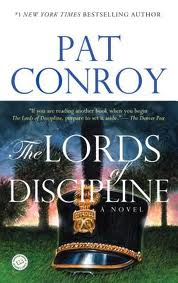Recommended for adults.
In anticipation of going to a conference in Charleston, South Carolina later this year I sought out novels set there. I found a couple and I started with this one. Now that I have read it I am too drained to go on to the next one right away. It is a wringing experience to follow these lords of discipline.
To say that the novel is an account of the education of four students at a college is true but without texture or meaning. The four are boys from 18 – 21 years old. The college is a military school. It is in Charleston.

The major characters, in addiiton to the four room-mates, are the president of the college, the dean of students, the family of one of the boys in the room, and a love interest for the narrator. But the major character is Charleston itself, its foliage, its seasons, its smells, its beaches, its grass, its insects, its social conventions, its colonial origins, its Confederate past, its slave past, its caste system. As a book to read before visiting Charleston it is exactly right. (Though it did not tell me why that 1920s dance is called ‘Charleston.’)
What happens? The boys learn a lot and our protagonist grows up. The novel is rich with incident and offers a flavour of that all male environment where brutality taken and brutality given is the road to manhood. To list all of the examples would make it seem a litany of violence and blasphemy, and it is not. Though there is plenty of both.
Conroy alternates very deftly between the systematic beastiality of some events at the school with lyrical descriptions of the coastal wind, or tiered reflections on love and life by the boy becoming a man. Conroy’s judgment in measuring for the reader doses of pain with relief from it is sure. He guides the reader through the distasteful parts by providing oases before moving on.
Throughout the prose is beautiful, elegiac for lost youth.
None of the characters are cardboard. Even the president, a thinly disguised representation of Douglas MacArthur, and the many who imitated him, is developed. He has his reasons, convoluted and self-serving though they be, but they are not idiosyncratic or synthetic. He is not simply a plot device. The same goes for the Dean of Students, the Commandant. He is not honest but he is trying to do what is best.
Of course the most well developed character is the narrator who tells some of this in retrospect. His inner confusions, contradictions, volte faces, his mistakes, his blunders, are very touching as he recovers from romantic rejection, deals with social ostracism, copes with responsibilities shoved onto him, is rocked by betrayal, weighs the demands of friendship…. Life is complicated at any age but the more so for youth.
The other three room-mates are also developed personalities, though we see them only in relation to the narrator. The other cadets, even the sadists, are presented as human beings, despicable though some are, and not merely as plot devices. It is a great talent that can do that. Conroy seems to be in complete control and command of the novel; he is no child prodigy but a mature observer and a seasoned ponderer on the human comedy.
All of this is played out against the times in the United States in the 1960s. Civil rights and integration of this school, and the Vietnam War in which many of the graduates of the school have already served. But always more important than these externalities is the school itself and its very Charleston cosmology.
There is enough violence, profanity, stupidity, and prejudice in the book to interest a Hollywood film producer in turning it all into slam-bang cardboard. Read the book, skip the film is my advice.
Conroy has written much else, like The Great Santini, and I will read more some time. I also plan to re-read another book about a military school. It will be Calder Willingham’s End as a Man (1947). His most arresting character was not the victim but the vicious bully.
Having finished the book and before gathering my own thoughts I looked for reviews but all I could find were hundreds of comments on Good Reads and Amazon, and those I scanned were as inane as most comments on Trip Advisor. Most are about that fascinating subject, the writer of the comment, and not about the book. These are no doubt the same twits who FaceBook their every meal. I am sure there are measured and informative reviews available but they are overgrown with the obscuring and choking vines of the Twitterati. I am left to my own devices.
Skip to content
